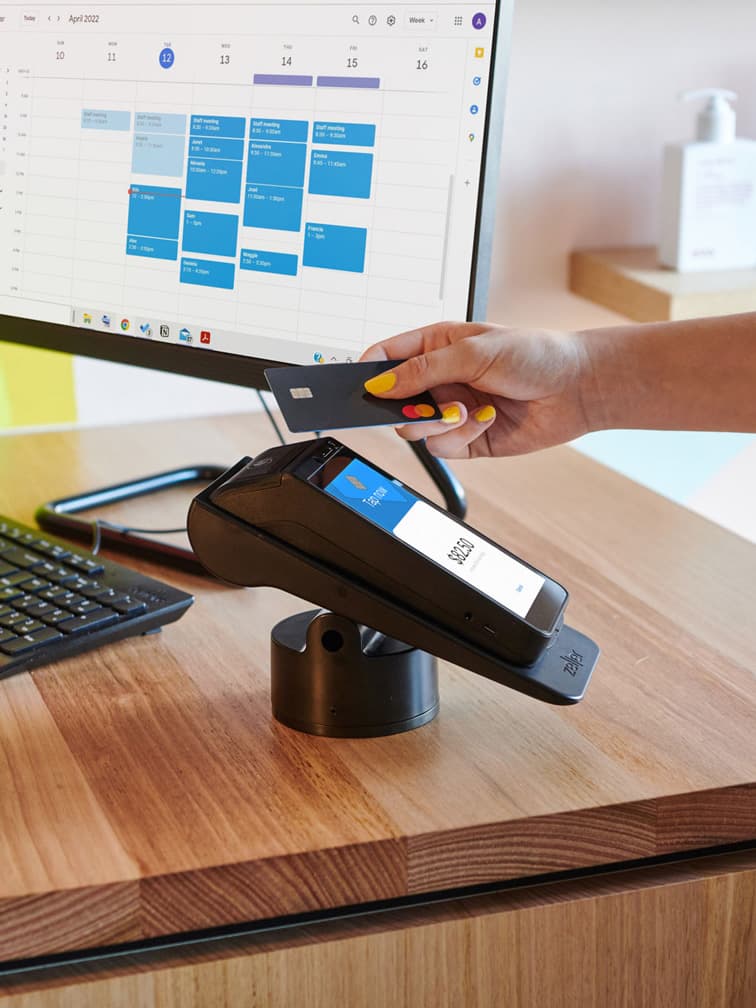
- Business Growth & Optimisation
2022-23 Federal Budget: 10 Things Merchants Need to Know
Looking to hire, upskill staff, or purchase new tools? You're in luck.
In the weeks leading up to the official announcement, there has been mounting pressure on the government to consider more targeted measures aimed at helping business owners.
Although the 2021-22 Budget tackled some key areas of concern, the Omicron variant had not yet reached Australian shores. Since then, many capital cities and surrounding areas have suffered through extended lockdowns — once again shuttering businesses, and slowing economic recovery. With the added pressure of widespread supply chain issues, the rising cost of living, natural disasters, a significant lack of staff, and low consumer confidence, it’s been a difficult couple of years for businesses in particular.
There’s been a lot of cash splashed recently, and it’s left a dent. Australia is currently sitting on some of its highest debt levels in history, and the debt forecast is set to hit $1 trillion in 2023-24. Although Treasurer Josh Frydenberg forewarned that this year’s Budget would curb some spending, the government appears to have recognised that now is the time to prioritise economic recovery over debt repayment.
Keep reading to discover what new measures will be introduced, which existing schemes will be extended, and what the impact is on your business
1. A new system for apprentices
Looking for an apprentice chef? Or a trainee hairdresser, or an apprentice plumber? Now’s the time to hire.
The Boosting Apprenticeship Commencements wage subsidy scheme, a program that supports employers of any size to take on new apprentices or trainees, has been extended to the end of this financial year. Any employer who takes on an apprentice or trainee (under an approved training contract) on or before 30 June 2022 can gain access to:
50 per cent of the eligible Australian Apprentice’s wages in the first year (capped at $7,000 per quarter)
10 per cent of the eligible Australian Apprentice’s wages in the second year (capped at $1,500 per quarter)
5 per cent of the eligible Australian Apprentice’s wages in the third year (capped at $750 per quarter)
It’s a move expected to support 35,000 extra apprentices and trainees, shoring up our local skills pipeline and getting more people into work. Importantly, the program can be used to employ retrenched apprentices and trainees who lost their job due to the pandemic.
When the financial year ends in June, the scheme will be replaced by the newly announced Australian Apprenticeships Incentive System, which will subsidise the wages of trainees in priority fields by up to $4,500. Under the scheme, priority apprentices will also receive $5,000 in training support payments.
In-demand, “priority” fields are as yet unclear. However, a new Australian Apprenticeships Priority List will be created and expanded upon annually — so stay tuned.
2. Deductions for digital tools
Looking to upgrade your digital skills and tools? Businesses with annual turnover of less than $50 million will be able to claim a 20 per cent deduction on the cost of workplace expenses that support their digital uptake — think e-invoicing, accounting, web design, and cloud computing.
The deduction will apply to any purchases made between 7.30pm on March 29, 2022 and June 30, 2023, up to a limit of $100,000 in expenditure per year.
3. Tax cuts for employee training
Small business owners will also be able to deduct an extra 20 per cent of expenditure on external training courses under the new Skills and Training Boost — a move that has the potential to upskill approximately 7.8 million Australians employed by eligible businesses. What this means in effect is that for every $100 a small business spends on training its employees, it will get a $120 tax deduction.
There are conditions, of course. In-house or on-the-job training is ineligible, for example — the courses must be run by registered training entities. Keep an eye out for more details, when they become available — this is a measure your employees will want to know about, too.
4. Instant asset write-off extension
In the lead-up to this year’s budget announcement, industry groups have made no secret of the fact that ongoing supply chain issues have pushed the cost of new purchases higher and added considerable delays to shipping times. Yet in a move designed to encourage spending, the temporary full expensing scheme has been extended once again.
The instant asset write-off scheme’s eligibility criteria was dramatically expanded in 2020, and last year’s budget extended the scheme to apply. After the most recent budget announcement, business owners can now claim the write-off on eligible assets first used or installed by June 30, 2023.
The scheme, which allows businesses with a turnover or income of less than $5 billion to immediately write off the cost of purchasing new capital items, has been credited with causing a spike in equipment like tractors and utes. If you’re considering a new business purchase, now’s the time.
5. Changes to PAYG
Many merchants that pay the Australian Taxation Office a portion of their expected tax liability have typically been subject to a 10 per cent uplift rate. The government will reduce that rate to 2 per cent for the 2022-23 financial year, significantly reducing the buffer for scheduled payments.
It will also be easier for businesses to get refunds on instalments. In the event business performance declines and tax liability is reduced, merchants may be able to get refunds of instalments paid immediately.
It’s a move projected to provide cash flow support to around 2.3 million small-to-medium businesses and sole traders.
6. Ripping up the red tape
The government has announced a ream of measures to ease the impact of regulatory red tape on business owners.
From January 2024, businesses will be able to automatically report taxable payments via software at the same time as activity statements. Meanwhile, the government will be developing systems to ensure all trusts in Australia will be able to lodge income tax returns electronically from July 1, 2024. These changes will significantly reduce the administrative headache for business owners, minimise errors and speed up processing times.
Fuel and alcohol importers and distributors with an annual turnover of less than $50 million will be able to lodge and pay excise and excise-equivalent customs duty on a quarterly basis from July 1, 2023.
7. Hiring subsidies for seniors with disabilities
Employers that hire seniors with a disability will be eligible for subsidies of up to $10,000. The package, which comes at a cost of $44 million, is intended to incentivise businesses to broaden their workforce.
Given the chronic staff shortages faced across the country, it’s a measure that could tackle two birds with one stone: helping to alleviate some of the pressure on business owners, while growing and diversifying the workforce.
8. Temporary cost of living measures
Around 6 million Australians will be eligible for a one-off payment of $250 to meet the rising cost-of-living pressures. Most of those who will receive the payment are pensioners, but some carers, veterans, job seekers, self-funded retirees and concession card holders are also eligible. Recipients will have the one-time-only payment deposited into their bank accounts in April.
The rate of fuel duty has also been slashed in light of the astronomical rise of petrol prices. Bowsers in several markets across Australia have recently been set above $2 a litre, adding considerable pressure to motorists. For six months, the government will cut the fuel excise — the flat tax levied on each litre of fuel — in half. Mr Frydenberg says this spells average savings of 22 cents a litre, which is good news for all motorists (and great news for mobile business owners).
9. An extension to the LMITO
The low to middle income tax offset (LMITO) has been extended for another year. Individuals already receiving the offset will get up to $1500, and couples will receive up to $3000 in their 2021-22 tax returns. The offset, which was originally due to end at the close of this financial year, will be welcome relief for approximately 10 million Australians who will also receive a one-off $420 cost of living tax offset.
10. A regional telecommunications overhaul
The government has pledged $18 billion for the investment pipeline, which includes more than 20 new and existing road and rail projects across the country.
In good news for regional businesses, $1.3 billion will be spent improving telecommunications in regional areas — meaning businesses should face fewer and fewer disruptions from outages, and have better backup in the event of natural disasters.
What do you think of this year’s Budget?
Given the election’s proximity, this year’s Budget was not expected to rock the boat. Fewer new regulatory measures were introduced than usual, which will give merchants breathing room to focus on the challenges posed by the current business climate. However, the coupling of new measures designed to support the digital transformation of small businesses, additional tax cuts for staff training, and a further extension of the instant asset write-off will be welcome news to many.
Depending on your industry, there could be some changes to put in place. Now’s the time to look at hiring an extra set of hands, upskilling your staff, and seriously considering whether there are business purchases you could make to help grow your business. For those with staff, remember superannuation will once again rise on 1 July 2022.
Let us know what you thought of this year’s Federal Budget on Facebook, Instagram, or LinkedIn.
To fully prepare your business for the impact of this year’s Federal Budget, schedule time to speak with your accountant or financial advisor. Please note this article is for educational purposes only. Zeller does not accept responsibility for the accuracy of the information presented in this article.



